Source: The IceCube Neutrino Observatory
Flying through IceCube strings
Ve Vm Vt. The Ideal Cosmic Messengers
In their critical description of the IceCube Neutrino Observatory, Sasha Engelmann and Jol Thomson guide us into the depths of Antarctica’s ancient ice where ghost-like neutrinos cast electromagnetic showers, or cascades, as they chance to interact with the Earth. In this way, neutrinos challenge notions of scale and boundedness in the physical sciences and the technosphere.
ACT I: Thinking Neutrinos
SASHA: The neutrino is omnipresent. It is a phantom. It oscillates, that is, unlike other particles it changes as it travels. It is often called the “ideal cosmic messenger.” Trillions of neutrinos are passing through our bodies and through this text at this very moment ‒ an invisible rain.
- JOL: Neutrinos are subatomic particles, or leptons, that interact only via the “weak force”: the force that governs particle decay; fusion and fission processes. Unlike all other known forms of matter, they are not susceptible to electromagnetic fields, and so they travel in nearly perfect straight lines. It is said that a neutrino could pass through 100 Light-years of Lead without ever slowing down.
SASHA: Due to these qualities, neutrinos often evade determination, experiment, observation, measurement, and manipulation ‒ they are the radically imperceptible.
- JOL: The neutrino was once the most probable candidate for the “missing mass” that physicists call dark matter. Although this hypothesis has been refuted now, neutrinos are nevertheless integral to our understanding of other "weak interactors": dark matter and, perhaps, energy. Since they are so abundant and yet so elusive, they summon an entirely new genre of experimental physical observation ‒ which has a host of implications outside the scope of this dialogue. Even with the most sophisticated technologies, we can only sense neutrinos as traces, when they rarely interact (decay) with charged matter, producing “electromagnetic and hadronic showers,” or: cascades.
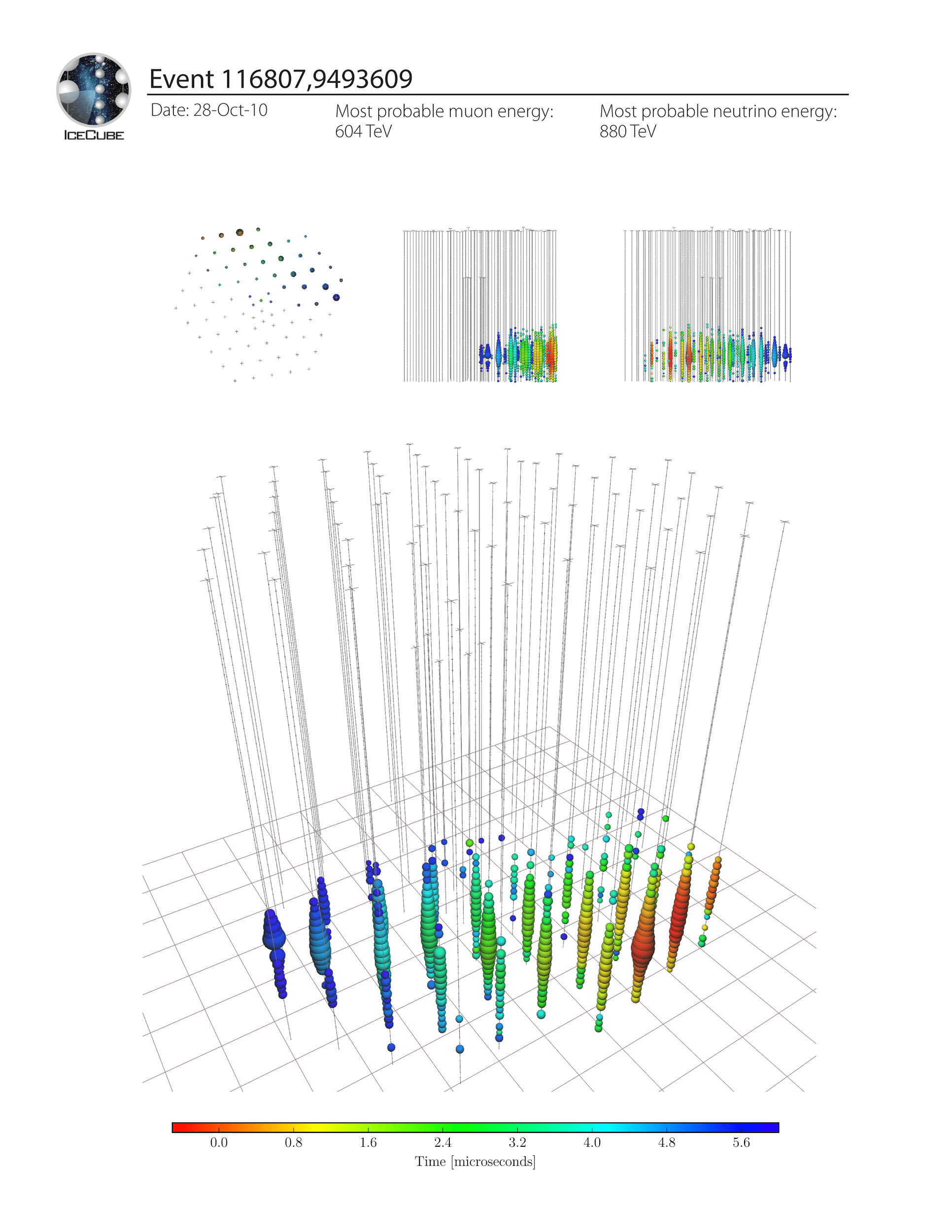
large
align-left
align-right
delete
- JOL: Neutrinos help us think.Here, we are inspired by the lines, “Think we must. We must think,” at the beginning of Donna Haraway’s essay "Tentacular Thinking: Anthropocene, Capitalocene, Cthulucene," e-flux, no. 75 (September 2016). Haraway remembers these lines from Isabelle Stengers and Vincianne Despret’s work, Women Who Make a Fuss: The unfaithful daughters of Virginia Woolf, trans. April Knutson. Minneapolis, MN: Univocal, 2014. The neutrino is our collaborator in, among other things, thinking about the limits of technologically extended sensing. It is a guide asking us questions about the articulation of the technosphere.
SASHA: But how does it do this?
- JOL: Because it motivates spectacular, post-human assemblages of sensing, where the distinction between what constitutes technology or nature is complicated. We could also say that the neutrino is luring the Technosphere outside of itself. The otherwise imperceptible neutrino organizes vast assemblages of materials, built infrastructures, devices, humans, ice sheets, equations, knowledge systems, oceans, algorithms, laws, and discourses. With these subatomic particles as our cosmic allies, we are equipped to reclaim territory from the unknown, and to ask questions of the technosphere’s capacity to be what it claims to be: a sphere. And we are motivated to highlight the inadequacies of static conceptions of scale and agency in thinking with our unique planet.
H
delete
ACT II: The-Cubic-Kilometer-of-Antarctic-Ice-Observatory
SASHA: What do we mean by “spectacular” forms of sensing? There are many ways to sense neutrino-traces. And there are many kinds of neutrinos. There are atmospheric neutrinos (those produced from the interaction of cosmic rays in our atmosphere), and geo-neutrinos (those produced from Earth’s core). But let’s focus on extragalactic neutrinos: those very high-energy neutrinos that are emitted from black holes, active galactic nuclei, and supernovae far outside our galaxy. These neutrinos travel vast distances, through interstellar space.
- JOL: Extragalactic, high-energy neutrino detection requires a clearing of the field, a level of cosmic silence, that, on the extremely rare occasion of a neutrino's decay, will allow a neutrino cascade-event to be sensed. Thus, many "neutrino telescopes" are situated deep underground in repurposed mines or caverns ‒ the quietest places in our planet. In the case of detectors such as Super-Kamiokande in Japan ‒ comprising a fifty-thousand-liter tank of ultra-pure water buried deep below the Japanese Alps ‒ the rock above the sensor apparatus acts as a shield from other high-energy particles that are constantly showering the planet. Rock, strata, natural and artificial caves: even the Mountain becomes a technology. Technology becomes a Mountain.
SASHA: Detecting these high-energy “cosmic messengers” also requires what sounds like science fiction: the cooperation of a cubic kilometer of ancient Antarctic ice.
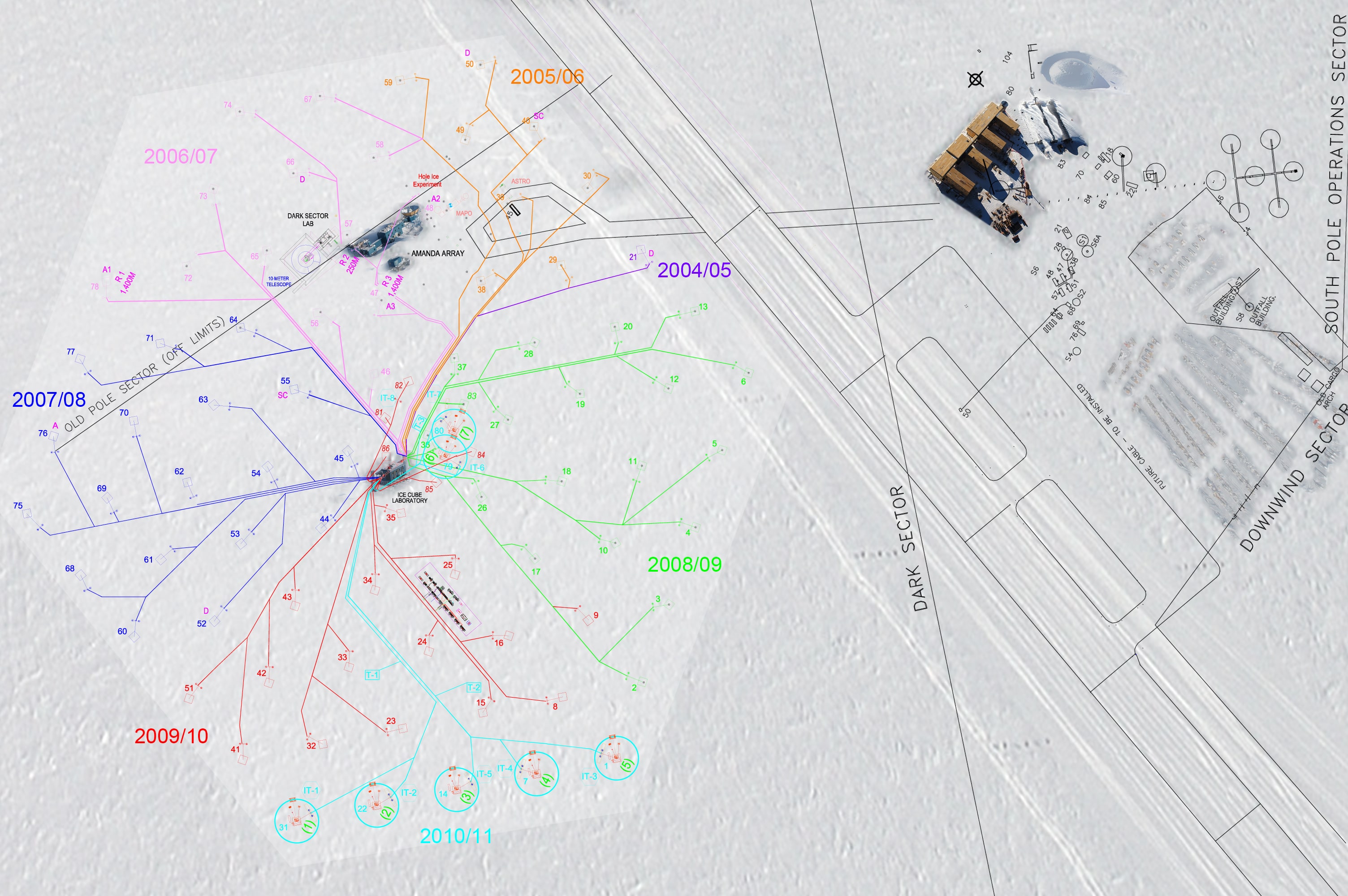
large
align-left
align-right
delete
SASHA: One of the youngest and most prolific “neutrino telescopes,” and that which has been the subject of our ethnographic fieldwork – the IceCube Neutrino Observatory – . . .
- JOL: . . . is embedded 2.5-kilometers down ‒ into the 200,000-year-old ice shelf at the Amundsen-Scott South Pole Station in Antarctica ‒ at the Geographic South Pole.
SASHA: The IceCube physically comprises eighty-six strings hexagonally latticed, instrumented into one-cubic kilometer of Antarctica’s snow-ice. Each string has sixty sensors, or “Digital Optical Modules” (DOMs) which are sensitive to Cherenkov radiation (more on that below). The IceCube uses 5,160 DOMs in total, to sense neutrinos across a 25 order of magnitude energy spectrum. You can think about it as a massive molecular crystal with threaded beads extending kilometers deep into solid ice ‒ with a tiny research station (the "IceTop") perched on top, like a frozen spider.
- JOL: The IceCube Neutrino Observatory represents one of the largest, strangest, and most complex collaborations in the history of scientific research. The collaboration essentially spent 300 million dollars to stare into ice. Nostradamus stared into Obsidian. Hamlet scryed a cloud. Like so many ancient forms of crystallomancy, hydromancy, and geomancy, the IceCube apparatus captures visions of another world in a translucent body. Visions looking both forward and back: tracing the outlines of dying stars millions of light-years away, or looking beyond the cosmic microwave background to see the first 380,000 years of the Cosmos.
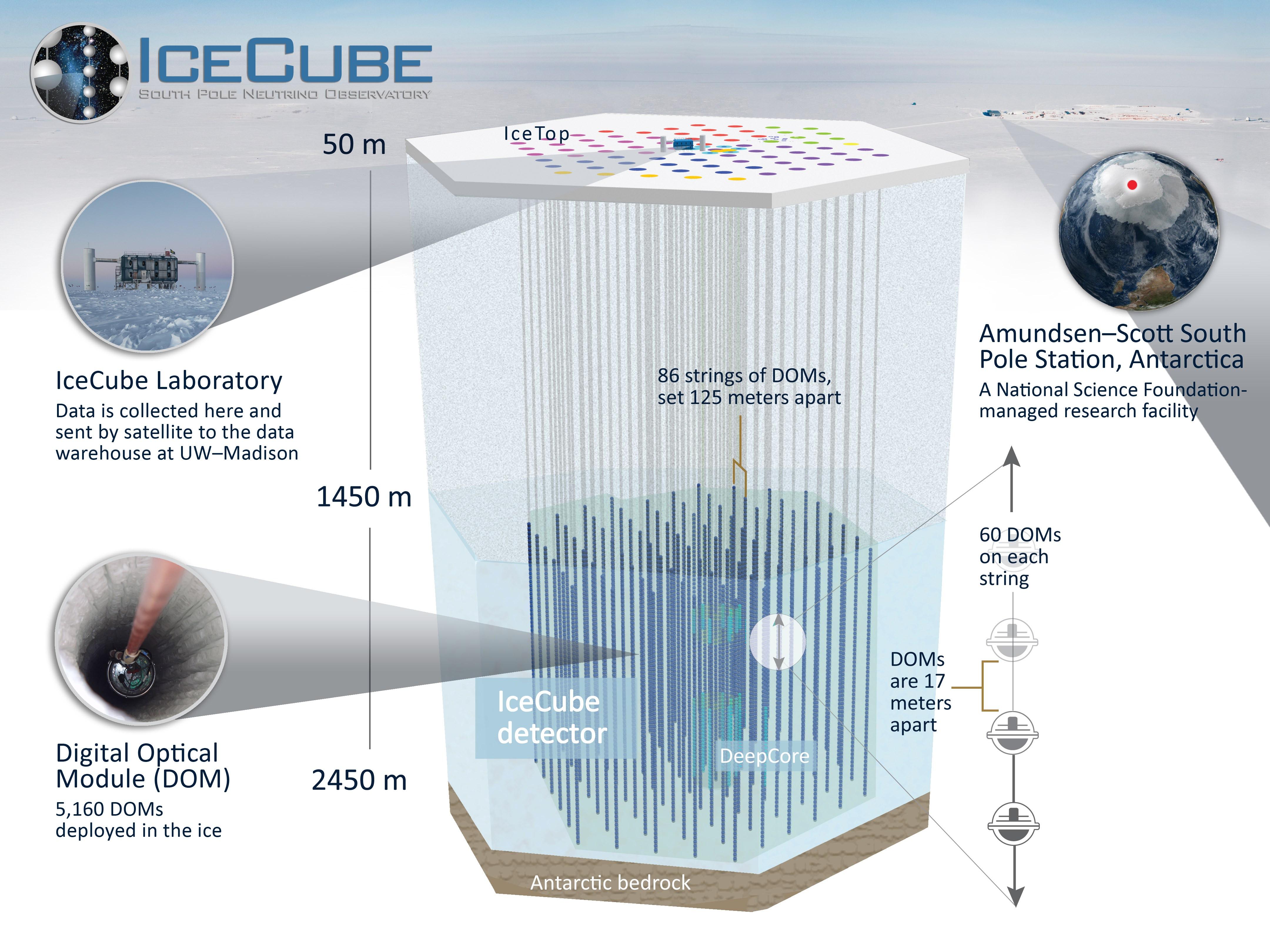
large
align-left
align-right
delete
SASHA: When a high-energy neutrino flying through space passes through the Earth and interacts with a molecule of this Antarctic ice, the resulting blue Cherenkov radiation is sensed by the IceCube’s DOMs. Cherenkov radiation is an ultraviolet evidence of particles traveling faster than the speed of light in the ice-medium ‒ they are superluminal. The DOMs analyze, amplify, and digitize the information to send to the IceTop, and via satellite to hundreds of scientists around the world. The neutrino intra-acts with all of the entangled agencies implicated in the IceCube, with the technosphere itself, with our writing this text, with the magazine you are reading, with the website hosting it. In many ways, you are reading this because a neutrino arrived on Earth four years ago, and its name was Bert.In an interview, the director of the IceCube Neutrino Observatory, Dr. Francis Halzen, told us that after much discussion among PhD students, the first high-energy neutrino to be sensed by the IceCube Neutrino Observatory was nick-named Bert.
- JOL: Neutrinos as lures for thought are diverse. Take for example the superluminal Cherenkov blues of radioactive decay. Here is another example of a “limit,” or a cosmic and physical law, shown to be a relative, contingent form of resistance. Einstein’s famous speed limit for light is only applicable for the spaces between things ‒ for the vacuum of space ‒ and does not apply to atmospheres, bodies, metals, water, or ice. There are hosts of occasions where energy and particles travel faster than light, and these leave an ultraviolet trace.
SASHA: In fact, the same researchers at the Deutsche Elektronen-Synchrotron (DESY) laboratory in Zeuthen, who designed and constructed the IceCube’s sensors, are building the CTA or Cherenkov Gamma Ray Telescopes in Spain and Chile, which will sense these superluminal blues in our own atmosphere, where particles exceed the speed of light in the medium of air.For more information, see [CTA Telescopes planned for sites in the Northern and Southern hemispheres](https://portal.cta-observatory.org/Pages/Home.aspx).
ACT III: Are there Cascades in the Technosphere?
SASHA: In dialogue with the technosphere, we have one further question: If an Antarctic ice shelf is actually the “detector” for this cosmic messaging, can we still speak of boundaries or “spheres” of the human, the bio-geo-physical, and the technical?
- JOL: Let’s think a cascade: when a neutrino meets the ice. The neutrino cascade is a “waterfall of causality in which one event triggers and affects the next.”Our emphasis, see Fulton cited in Kathleen Rooney, Review of Cascade Experiment: Selected Poems. Harvard Review, (27), 2004, 176. Retrieved on 21st August 2015 from http://www.jstor.org/stable/27568963 Each cascade is a bifurcation and a nexus: while the event occurs on a subatomic dimension, and is sensed via Cherenkov radiation, a cascade transmits the direction, energy level, and location of the neutrino’s astrophysical origin. In this way, subatomic and cosmological entities and forces are intimately entangled in the performance of a cascade. They perform simultaneously. They cannot be separated.
H
delete
- JOL: In the ice, a cascade also occurs across hundreds of meters.
SASHA: When a cascade unfurls, it is felt as a pulse in the technosphere. The data is almost-instantly transmitted to processing centers in Wisconsin, through arrays of satellites and algorithmic sorting. Servers are alerted. PhD students awake. Francis Halzen’s telephone rings. Theories are born. Rumors circulate. Another point is added to the neutrino “sky.”
- JOL: These phenomena lead us to understand the cascade as the expression of entanglement in the liminal spaces between subatomic particles, an ice shelf, digital sensors, human labor and curiosity, equations, hypotheses, and vast technological and bureaucratic architectures. Sending shock waves across such assemblages, cascade phenomena collapse static, singular notions of scale(s) and trouble the distinctions between human and nonhuman, technology and matter.
SASHA: To be sure, a neutrino cascade is an unusual event. But it is one we can use to think more about scale and agency.
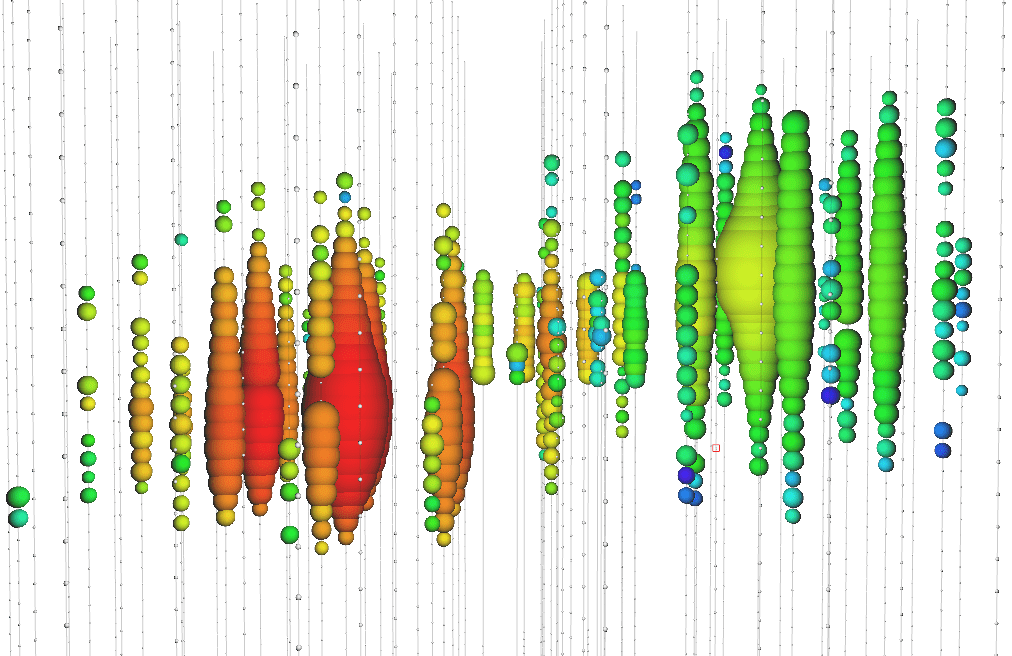
large
align-left
align-right
delete
SASHA: In the literature developing the Technosphere concept, relations between humans, nonhumans, and the technosphere are often articulated in “small-scale” and “large-scale” components. Scale, categories, and spheres are useful analytical tools. However, they cannot be the only tools we use, especially when faced with such superluminal visions. Indeed, what might be lost in the gesture of defining the relations between humans, nonhumans, and technical infrastructures using categories like large and small?
- JOL: If we accept static scales, spheres, and boundaries as primary regimes of analysis, there would be no cascades in the technosphere. These events would be, at best, hallucination. We need other tools, other concepts for thinking and feeling, for being and becoming more sensitive. The cascade is such a concept. With the cascade, we find that a single neutrino sends ripples through devices, computations, infrastructures, scientific collaborations, theories, and imaginaries of the universe.
SASHA: This brings us to our next provocation.
ACT IV: New Physics in the Technosphere?
JOL: According to Dr Francis Halzen and numerous other neutrino physicists, the strange qualities of neutrinos provide experimental evidence that the Standard Model ‒ the “Rule Book” of Physics ‒ is flawed. A new, “exotic” model, therefore, is glimpsed in neutrino astronomy and physics.
- SASHA: The rule book may be flawed, because it doesn’t account for the degree to which neutrinos oscillate between “heavier” and “lighter” masses. There is a “non-zero flavor oscillation” of neutrino particles which, properly described by a joint Japanese‒Canadian effort, won the Nobel Prize in Physics in 2015.For more information on the Nobel Prize in Physics, won jointly by Dr Takaaki Kajita and Dr Arthur B. McDonald, see [online] (https://www.nobelprize.org/nobel_prizes/physics/laureates/2015/) In other words, for neutrinos, to change flavor is to change mass.
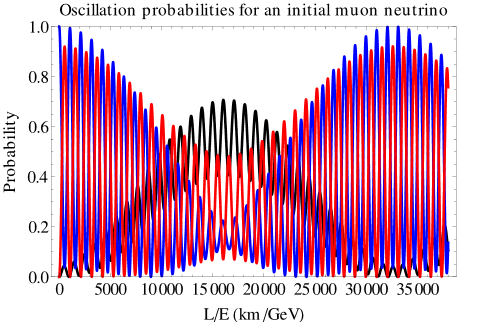
large
align-left
align-right
delete
JOL: The capacity for a particle to change mass in mid-flight is another indication of limits being transcended.
- SASHA: The search for dark matter plays a role here. A better rule book for physics would describe and account for the behavior of dark matter particles, which, like neutrinos, interact very weakly with matter.
JOL: A new or “exotic” model of particle physics is sought-after by many physicists for many reasons. Some of these reasons may be born from the adventure of discovery; others from a desire to witness a more elegant “theory of everything”; yet others for the more pragmatic reasons of funding and institutional support; and still others to reclaim territory from the unknown.
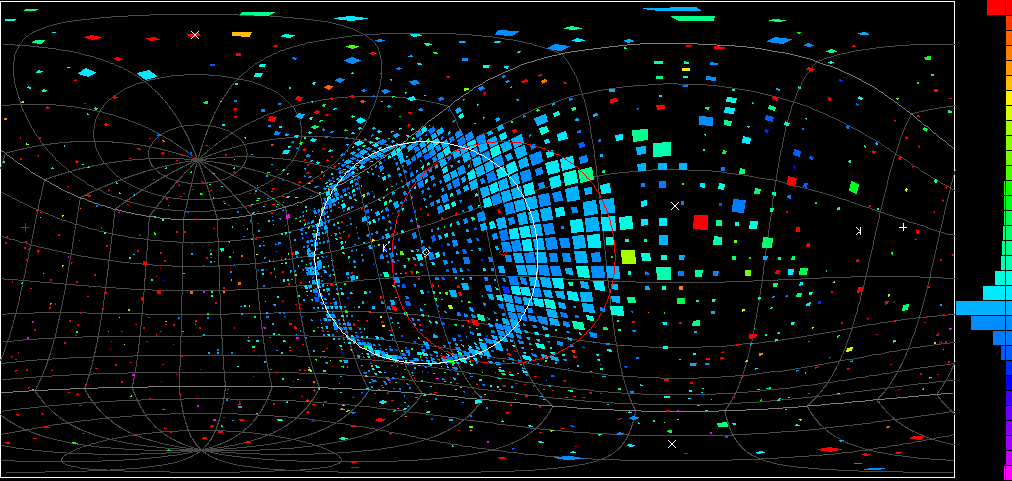
small
align-left
align-right
delete
- SASHA: Such a model has interesting consequences for the expression of our planet’s technosphere insofar as it could redefine the “quality energy” that supports it. And it is precisely our ghost-like collaborators, their cascading performances, and the bodies of the Earth conspiring to detect them, which are announcing new ways of thinking, doing, and engaging with these dark and “exotic” matters.
JOL: This is the technosphere lured outside itself; lured outside its own imposed limits, infrastructures, equations, knowledge systems, discourses, and devices. And it is lured toward new horizons of energy, description, and matter. It is apprehending a Great Outdoors.The term “Great Outdoors” is a fundamental concept in the articulation of the speculative philosophy of Quentin Meillassoux. The term indicates an ancestral spacetime “outside” of human thought and existence. It is conveyed through ‘arche-fossils’ such as radiocarbon dating, or in our case, neutrinos. See Quentin Meillassoux, After Finitude, trans. Ray Brassier. London: Continuum, 2008.
ACT V: Who’s afraid of Karen Barad?
SASHA: Thinking with neutrinos, we have set out some implications for understanding the technosphere. We proceed with the physicist-philosopher Karen Barad.
- Neutrinos lure the technosphere outside itself. “The entity in question may be small, but its consequences may be quite profound.”See Karen Barad, Meeting the Universe Halfway: Quantum Physics and the Entanglement of Matter and Meaning. Durham: Duke University Press, 2007: 110.
- Neutrinos invite us to think the technosphere otherwise, in terms that do not rely on scalar analysis. We need trans-scalar concepts (e.g. cascades) to approach the agential and technical capacities of our planet. “Events and things do not occupy particular positions in space and time; rather, space, time, and matter are iteratively produced and performed [. . .]. The very nature and possibilities of change are reworked.”(Barad, 2007: 393)
- Limits are situated constructions. They can be better understood as greater or lesser degrees of resistance. “Boundary transgressions should be equated not with the dissolution of traversed boundaries (as some authors have suggested) but with the ongoing reconfiguring of boundaries [. . .] the neutrino, passing through matter as if it were transparent, innocently traversing all borders [. . .] with undiscriminating ease and disregard for obstacles [. . .] the realization of a mobility and reach that know no bounds.”(Barad, 2007: 245-246)
- The articulation of limits in the development of the technosphere is a disservice to the concept because it excludes important questions and insights, as well as vast phenomenal realms (e.g. neutrinos and cascades). “Apparatuses, in Bohr’s sense, are not passive observing instruments. On the contrary, they are productive of (and part of) phenomena [. . .]. But while focusing on the lack of an inherent distinction between the apparatus and the object, Bohr does not directly address the question of where the apparatus “ends.” [. . .] For example, if a computer interface is hooked up to a given instrument, is the computer part of the apparatus? Is the printer attached to the computer part of the apparatus? Is the paper that is fed into the printer? Is the person who feeds the paper? How about the person who reads the marks on the paper? [. . .] What precisely constitutes the limits of the apparatus that gives meaning to certain concepts at the exclusion of others? [. . .] What is needed is an articulation of the notion of apparatuses that acknowledges this complexity.”(Barad, 2007: 199)
- There is a Great Outdoors.
EPILOGUE
An ice shelf is a detector and the technosphere is of the world, just as are humans and neutrinos. All of our elements, ghosts, and particles, wrought together, are like so many ice-embedded modules peering into the crystal cosmos, waiting for the message to arrive.
H
delete